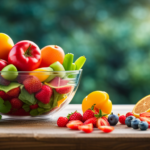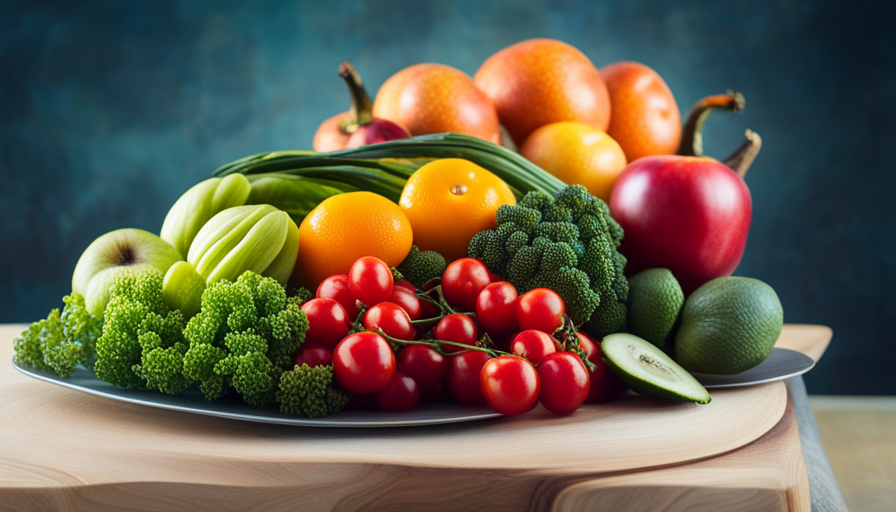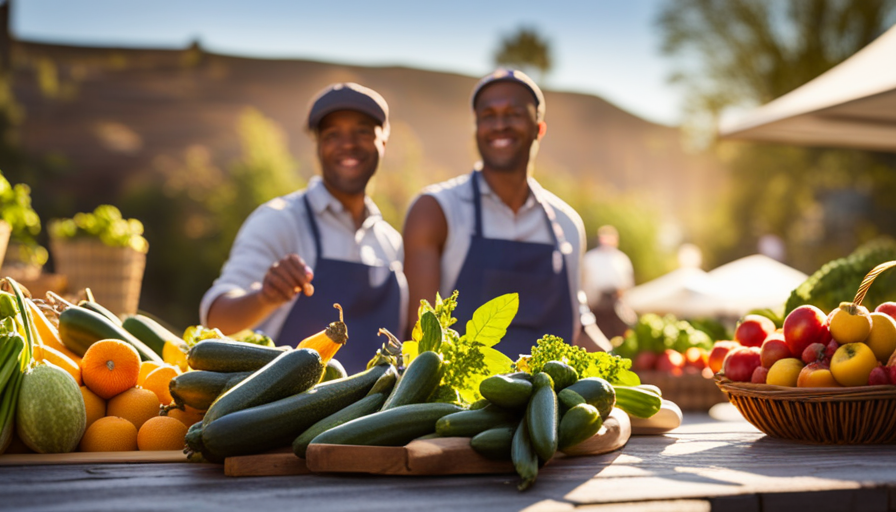Picture a scenario where our bodies operate like efficient machines, functioning at their best and devoid of the challenges of sickness and exhaustion. In this world, robust health is standard, and we enjoy endless energy, mental clarity, and a radiant appearance. This reality is real, my friends, and it is attainable through the raw food diet.
Embarking on the raw food diet is akin to stepping into a lush, abundant garden, where every bite is a symphony of flavors and nutrients. It is a lifestyle that celebrates the power of nature’s bounty and embraces the transformative potential of uncooked, unprocessed foods.
But how do most people feel about this dietary choice?
In this article, we will delve into the experiences of individuals who have embraced the raw food diet. We will explore the reasons for choosing this path, the initial challenges and adjustments, the physical and mental benefits that await, and the nutritional considerations that must be taken into account.
We will also discuss meal preparation and planning, overcoming plateaus, and the long-term sustainability of this lifestyle.
Join me on this enlightening journey as we uncover the truth about the raw food diet and how it can revolutionize our lives.
Reasons for Choosing a Raw Food Diet
You’ll love the raw food diet because it allows you to enjoy the natural flavors and textures of fresh fruits and vegetables while also promoting a healthy lifestyle. One of the main reasons people choose to transition to a raw food diet is for its potential health benefits.
Raw foods are rich in vitamins, minerals, and enzymes that can be destroyed through cooking. By eating raw, you can maximize the nutritional value of your food and support your overall health. Additionally, a raw food diet is often associated with weight loss and increased energy levels.
However, it’s important to be aware of the potential health risks associated with a raw food diet. Some people may experience digestive issues, such as bloating or gas, due to the high fiber content of raw fruits and vegetables. Others may struggle to meet their nutrient needs, especially for certain vitamins and minerals that are more easily absorbed through cooking. It’s crucial to ensure you’re getting a balanced diet that includes a variety of raw foods to minimize these risks.
Transitioning to a raw food diet may require some initial challenges and adjustments. You may need to invest in a good blender or food processor to make raw food preparations easier. It can also take time to develop new recipes and meal plans that meet your nutritional needs. However, with patience and experimentation, you can successfully incorporate a raw food diet into your lifestyle.
Initial Challenges and Adjustments
Adjusting to a raw food lifestyle may initially present challenges as I navigated new eating habits and adapted to a different way of nourishing my body.
One of the initial struggles I encountered was the need to plan my meals carefully to ensure I was getting all the necessary nutrients. Unlike a traditional diet, where cooked foods can provide a wide range of vitamins and minerals, a raw food diet requires more intentional dietary adjustments. I had to learn about different food combinations and experiment with various recipes to create balanced meals.
Another challenge was the shift in my taste preferences. Raw foods have a distinct flavor and texture that may take some getting used to. Initially, I craved the familiar taste of cooked foods and found it difficult to resist temptations. However, as I continued on my raw food journey, I noticed that my taste buds started to adapt. I began to appreciate the natural flavors of fruits, vegetables, and nuts, and found satisfaction in their simplicity.
Adjusting to a raw food lifestyle also required me to make changes in my daily routine. I had to allocate time for food preparation, including soaking nuts and seeds, sprouting grains, and chopping fruits and vegetables. Additionally, I had to become more mindful of food storage and handling, as raw foods are more susceptible to spoilage and contamination.
Overall, the initial challenges and adjustments of a raw food diet were well worth it. The subsequent section will delve into the physical and mental benefits that come with embracing this lifestyle.
Physical and Mental Benefits
As you embrace a raw food lifestyle, you’ll discover a world of physical and mental benefits that’ll make you feel like a whole new person. Here are four reasons why the raw food diet can greatly improve your physical well-being and cognitive function:
-
Increased Energy Levels: Raw foods are rich in nutrients and enzymes that’re easily absorbed by the body, providing a natural energy boost. You’ll experience sustained energy throughout the day without the crashes often associated with processed foods.
-
Improved Digestion: Raw foods are packed with fiber, which aids in healthy digestion. This can alleviate common digestive issues such as bloating, constipation, and acid reflux. Your digestive system will function more efficiently, leading to better overall well-being.
-
Enhanced Mental Clarity: The raw food diet is known for its positive impact on cognitive function. The abundance of vitamins, minerals, and antioxidants found in raw foods nourish the brain, improving focus, memory, and mental clarity.
-
Stronger Immune System: Raw foods are bursting with immune-boosting nutrients that support a healthy immune system. By providing your body with the necessary vitamins and minerals, the raw food diet strengthens your body’s natural defense mechanisms.
As you transition to the next section about nutritional considerations, it’s important to understand how to maintain a balanced and diverse raw food diet to ensure you’re meeting all your nutritional needs.
Nutritional Considerations
When considering a raw food diet, it’s important to ensure that you’re getting sufficient nutrient intake. This includes making sure you’re getting enough vitamins, minerals, and essential nutrients to support your overall health and well-being.
Additionally, it’s essential to consider the sources of protein on a raw food diet, as protein is a crucial component for various bodily functions and muscle repair.
By understanding these key points, you can make informed decisions about your dietary choices on a raw food diet.
Ensuring Sufficient Nutrient Intake
To make sure you get all the necessary nutrients, it’s important for you to carefully plan your meals while on the raw food diet. Here are three key factors to consider when meeting macros and tracking nutrients:
-
Variety: Incorporating a wide range of fruits, vegetables, nuts, and seeds into your meals ensures a diverse nutrient profile. Aim for colorful produce to maximize vitamin and mineral intake.
-
Balance: Pay attention to the ratio of macronutrients – carbohydrates, fats, and proteins – in your meals. Including sources like avocado, nuts, and legumes can help meet your fat and protein needs.
-
Supplementation: While a well-planned raw food diet can provide most nutrients, certain micronutrients like vitamin B12 and omega-3 fatty acids may be challenging to obtain solely from plant sources. Consider consulting a healthcare professional about supplementation options.
Considering these factors will help ensure you maintain a balanced and nutrient-rich raw food diet.
Next, we will explore protein sources on a raw food diet.
Protein Sources on a Raw Food Diet
Getting enough protein on a raw food diet can be a challenge, but fear not, there are plenty of plant-based protein sources to keep you satisfied and strong.
While protein supplementation is an option, it’s important to focus on natural vegan protein sources that provide essential nutrients. Some excellent choices include legumes such as lentils and chickpeas, which can be sprouted and consumed raw.
Nuts and seeds, like almonds and chia seeds, are also rich in protein and can be easily incorporated into a raw food diet.
Additionally, leafy greens like spinach and kale offer a surprising amount of protein. It’s important to vary your protein sources to ensure a well-rounded nutrient intake.
Transitioning into the subsequent section about meal preparation and planning, it’s crucial to consider these protein sources when designing a raw food meal plan.
Meal Preparation and Planning
You’ll love how easy it is to plan and prepare meals on the raw food diet! Meal planning and grocery shopping become a breeze when you focus on fresh, whole foods. With a variety of fruits, vegetables, nuts, and seeds, you can create delicious and nutritious meals without much effort. To help you get started, here’s a table that showcases some simple meal ideas:
| Breakfast | Lunch |
|---|---|
| Green smoothie | Rainbow salad |
| Chia pudding | Veggie wrap |
| Fruit salad | Zucchini noodles |
| Raw granola | Nori rolls |
| Dinner | Snacks |
|---|---|
| Raw lasagna | Veggie sticks |
| Cauliflower rice | Energy balls |
| Raw pizza | Kale chips |
| Zucchini pasta | Almond butter |
These meal options are not only easy to prepare, but they also provide a wide range of nutrients. Planning your meals in advance allows you to make a grocery list accordingly, ensuring you have all the necessary ingredients on hand. By adopting a raw food diet, you can simplify your meal preparation while nourishing your body with wholesome foods.
Transitioning to a raw food diet may impact your relationships and social life, but it doesn’t have to be a barrier.
Impact on Relationships and Social Life
Navigating a raw food diet, have you ever wondered how it might impact your relationships and social life? Transitioning to a raw food diet can indeed have an impact on friendships and dating experiences. Here are a couple of key points to consider:
-
Social gatherings: Attending social events where the focus is on cooked food can present challenges. While it’s possible to find raw food options at some restaurants, it may be difficult to find suitable choices at others. This can lead to feeling left out or having to bring your own food to gatherings.
-
Understanding and support: Not everyone may understand or be supportive of your choice to follow a raw food diet. Friends and family members might question your decision or make unwelcome comments. It’s important to communicate your reasons for choosing this lifestyle and educate them about the health benefits.
-
Dating experiences: Going on dates can also be affected by a raw food diet. It may limit the choice of restaurants or make it more challenging to find a partner who is accepting of your dietary preferences.
Transitioning to a raw food diet can impact your relationships and social life in various ways. However, with open communication, understanding, and supportive friends, it’s possible to navigate these challenges.
In the next section, we will explore strategies for overcoming plateaus and sticking to the diet.
Overcoming Plateaus and Sticking to the Diet
When it comes to overcoming plateaus and sticking to the raw food diet, there are a few key points to consider.
First, dealing with temptations and setbacks can be challenging but it’s important to stay focused and motivated.
Finding support from like-minded individuals can make a big difference and help keep you on track.
Additionally, having a clear motivation and reminding yourself of the benefits of the raw food diet can help you stay committed and overcome any obstacles that come your way.
Dealing with Temptations and Setbacks
Although it may be challenging, it’s crucial to acknowledge and address the temptations and setbacks that come with following a raw food diet. Coping with cravings is an essential aspect of staying on track. When cravings hit, it’s helpful to have strategies in place, such as finding healthy alternatives to satisfy those cravings or distracting oneself with other activities.
Additionally, maintaining motivation can be key in overcoming setbacks. Reminding oneself of the benefits of the raw food diet, such as increased energy and improved digestion, can help stay focused. It’s also important to have a support system in place, whether it’s through online communities, friends, or family members who understand and encourage the raw food lifestyle.
By finding support and motivation, it becomes easier to navigate the challenges that come with following a raw food diet and continue on the path to better health.
Finding Support and Motivation
To stay motivated on your raw food journey, surround yourself with a supportive community that shares your passion for vibrant health and encourages you every step of the way. Finding a community of like-minded individuals who are also following a raw food diet can provide the support and motivation you need to stay on track.
Here are three ways to find support and stay motivated:
-
Join online raw food forums and social media groups where you can connect with others who are on the same journey. These platforms provide a space to share experiences, ask questions, and receive encouragement.
-
Attend local raw food meetups or potluck gatherings. These events offer an opportunity to meet others in your area who are following a raw food lifestyle. You can exchange recipes, share tips, and find inspiration from their success stories.
-
Consider working with a raw food coach or joining a raw food support group. These resources can provide personalized guidance, accountability, and additional motivation to help you stay committed to your raw food goals.
By finding a supportive community, you can stay motivated and inspired on your raw food journey. Transitioning to the next section about long-term sustainability and maintenance, it’s important to consider the challenges that may arise over time.
Long-term Sustainability and Maintenance
When it comes to long-term sustainability and maintenance on a raw food diet, incorporating cooked foods in moderation can be a helpful strategy.
While the raw food diet is primarily focused on consuming uncooked and unprocessed foods, adding some cooked foods can provide variety and make the diet more sustainable in the long run.
It’s important to strike a balance between meeting nutritional needs and sticking to the principles of the raw food diet, ensuring adequate intake of essential nutrients while still enjoying the benefits of a primarily raw food lifestyle.
Incorporating Cooked Foods in Moderation
You can still enjoy the benefits of the raw food diet while occasionally incorporating cooked foods in moderation. Although the raw food diet emphasizes the consumption of uncooked and unprocessed foods, there are some cooking techniques that can be used sparingly without compromising the health benefits.
Steaming, for example, is a gentle cooking method that helps retain nutrients in vegetables. Lightly sautéing or stir-frying vegetables can also add some variety to your meals. Additionally, cooking certain foods can make them easier to digest and enhance the absorption of certain nutrients.
However, it’s important to note that excessive cooking can destroy some of the valuable enzymes and vitamins found in raw foods. Therefore, it’s crucial to strike a balance between raw and cooked foods to ensure you meet your nutritional needs on a raw food diet.
Balancing Nutritional Needs on a Raw Food Diet
Finding the right balance between raw and cooked foods can be a challenge, but it’s crucial for meeting your nutritional needs and ensuring optimal health. Did you know that incorporating a variety of raw and cooked foods can help prevent nutrient deficiencies and promote overall well-being?
Ensuring nutrient diversity is important because different cooking methods can affect the nutrient content of foods. For example, cooking can increase the availability of certain nutrients like lycopene in tomatoes. On the other hand, some nutrients are better preserved in their raw state, such as vitamin C in fruits and vegetables. By incorporating both raw and cooked foods into your diet, you can maximize nutrient absorption and reduce the risk of potential deficiencies.
It’s important to note that raw food diets can still provide all the necessary nutrients, but careful planning is required. Transitioning to the next section, let’s address some common misconceptions and myths about the raw food diet.
Common Misconceptions and Myths
Addressing criticisms and skepticism, as well as debunking misinformation about the raw food diet, is crucial in dispelling common misconceptions and myths surrounding this dietary choice.
It is important to objectively address the criticisms and skepticism surrounding the raw food diet, providing evidence-based information to counter any doubts or concerns.
By debunking misinformation and sharing factual knowledge, we can help individuals make informed decisions about their dietary choices and better understand the benefits and potential drawbacks of the raw food diet.
Addressing Criticisms and Skepticism
Despite the skepticism surrounding the raw food diet, many individuals are embracing its potential health benefits. When dealing with criticism, it’s important to address the concerns raised about this diet.
One common concern is the lack of essential nutrients in a raw food diet. However, studies have shown that a well-planned raw food diet can provide all the necessary nutrients, including protein, calcium, and iron.
Another criticism is the potential risk of foodborne illnesses. It’s true that raw foods can carry bacteria, but proper food handling and washing techniques can significantly reduce this risk.
Additionally, some critics argue that the raw food diet is difficult to sustain long-term. However, with proper planning, education, and support, many individuals successfully maintain this lifestyle.
Debunking misinformation about the raw food diet, let’s explore the potential benefits it offers.
Debunking Misinformation about the Raw Food Diet
Misconceptions about the raw food diet often overlook the potential health benefits it can offer when properly understood and practiced. It’s important to debunk the false health claims and explore the reality of food safety when it comes to this diet.
To address the health claims, it’s crucial to note that the raw food diet can indeed provide numerous health benefits. Research suggests that it may improve digestion, boost nutrient intake, and reduce the risk of chronic diseases. However, it’s essential to maintain a balanced diet to ensure all nutritional needs are met.
When it comes to food safety, it’s a common misconception that raw foods are more prone to contamination. However, proper handling, washing, and sourcing of ingredients can minimize the risks. It’s also important to be aware of specific foods that may require cooking for safety reasons, such as eggs and certain meats.
Moving forward, personal testimonials and success stories provide valuable insights into the raw food diet’s impact on individuals’ lives.
Personal Testimonials and Success Stories
Many individuals have shared their personal testimonials and success stories about how they’ve thrived on the raw food diet, proving that it can be a rewarding and transformative lifestyle choice. One of the most common themes in these testimonials is the personal transformation that people experience when they switch to a raw food diet. Many report feeling more energetic, having clearer skin, and experiencing improved digestion.
Weight loss is another frequent benefit mentioned in these testimonials. People often share how they were able to shed excess pounds and maintain a healthy weight by following a raw food diet.
For example, Sarah, a 35-year-old woman, shared her success story of losing 30 pounds after adopting a raw food diet. She explained that she had struggled with weight issues for years and had tried various diets without long-term success. However, after transitioning to a raw food diet, she noticed a significant change in her body. She felt lighter, more vibrant, and found it easier to stick to her healthy eating habits.
Similarly, John, a 45-year-old man, shared his journey of personal transformation on the raw food diet. He had been overweight for most of his adult life and had developed various health issues. After switching to a raw food diet, he not only lost weight but also saw improvements in his blood pressure and cholesterol levels. He expressed how grateful he was for the raw food diet, as it had not only helped him lose weight but also improved his overall health.
These personal testimonials and success stories provide evidence that the raw food diet can have positive effects on personal transformation and weight loss. While individual experiences may vary, these stories offer hope and inspiration for those considering adopting a raw food lifestyle.
Frequently Asked Questions
Are there any potential side effects or risks associated with following a raw food diet?
Following a raw food diet may have potential side effects and risks. Long-term effects of this diet on digestion and gut health are a concern, as raw foods can be harder to digest and may lead to nutrient deficiencies.
Additionally, a lack of cooked foods in the diet can impact bone health and calcium levels, increasing the risk of osteoporosis.
It’s important to consult a healthcare professional before starting a raw food diet to ensure proper nutrient intake and minimize potential risks.
Can you still meet your nutritional needs, such as protein and vitamins, on a raw food diet?
Meeting nutritional needs on a raw food diet is possible, but it requires careful planning. While raw foods can provide essential vitamins and minerals, meeting protein requirements can be challenging. Plant-based sources like nuts, seeds, and legumes can help, but they may not provide the same muscle-building benefits as animal-based proteins. To maintain muscle on a raw food diet, it’s important to focus on combining different protein sources and ensuring adequate calorie intake. Consulting a healthcare professional or registered dietitian is recommended for personalized guidance.
How does being on a raw food diet affect your energy levels and overall well-being?
Being on a raw food diet can have a positive impact on energy levels and overall well-being. Raw foods are rich in nutrients and enzymes, which can support digestion and boost energy. Additionally, the high fiber content of raw foods can promote feelings of fullness and aid in weight loss.
Studies have shown that raw food diets can lead to weight loss and improved markers of health. However, individual experiences may vary, and it’s important to consult with a healthcare professional before making any significant dietary changes.
Are there any specific foods or ingredients that should be avoided on a raw food diet?
When following a raw food diet, it’s important to avoid certain foods and ingredients. Specific foods to avoid include processed and refined foods, such as white sugar and flour, as well as dairy products and cooked foods. These foods can be detrimental to the benefits of a raw food diet for weight loss. Instead, focus on consuming fresh fruits, vegetables, nuts, and seeds, which are rich in nutrients and enzymes that promote overall well-being.
Remember the adage, "You are what you eat."
How do you handle social situations, such as dining out or attending events, while following a raw food diet?
Handling social situations while following a raw food diet can be challenging, but with some tips, it becomes easier.
When dining out, I recommend researching restaurants in advance that offer raw food options or salads. I also suggest communicating with the waitstaff to ensure your dietary needs are met.
Attending events can be managed by bringing your own raw food snacks or eating beforehand. It’s important to be prepared and communicate your dietary choices to avoid any social discomfort.
Is There a Consensus on the Recommended Daily Caloric Intake for those on a Raw Food Diet?
The recommended daily caloric intake for those on a raw food diet can vary depending on individual factors such as activity level, age, and weight. However, a general consensus suggests that raw food diet calorie intake should prioritize nutrient-dense foods to meet energy needs while maintaining overall health.
Conclusion
In conclusion, the raw food diet can offer numerous benefits, both physically and mentally. While it may initially present challenges, such as meal planning and overcoming plateaus, many individuals have found long-term success and sustainability.
Contrary to common misconceptions, a well-planned raw food diet can provide all the necessary nutrients for optimal health. Personal testimonials and success stories further reinforce the positive impact this lifestyle choice can have.
So why not take a bite out of life and embrace the raw food diet? It’s the apple of your eye!

















